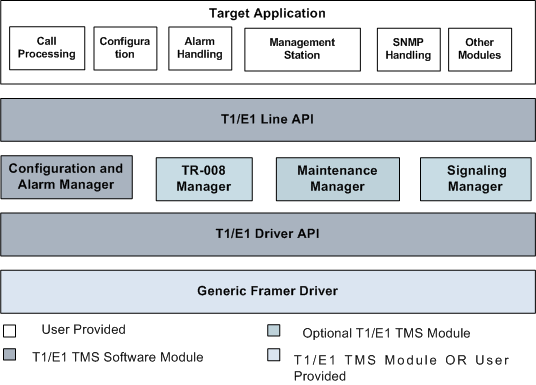T1/E1 WAN OAM Protocol SoftwareNComm’s T1/E1 Trunk Management Software provides a complete software solution for the implementation of a T1 and/or E1 system. It consists of a set of T1 software modules and E1 software modules that perform all aspects of T1/E1 support, from line alarming and maintenance to channelized signaling processing. Additionally, the T1/E1 software is completely data driven, allowing operating mode, alarm timers, and thresholds to be configurable on a static or run time basis. The suite includes 2 levels of ANSI-C Application Programming Interfaces (APIs), encapsulating the details of T1/E1 operation and the underlying hardware elements, and providing a clean integration to the target system’s operating environment. NComm’s T1/E1 TMS is supplied as ANSI C source code. User manuals, implementation training and technical support are also included with each license. A sample demo application provides functionality very quickly. This sample application also functions as a guide for integration of the T1/E1 TMS API into the upper management or control systems of your choice. The T1/E1 TMS also supports the Japanese standard for J1 operation. |
|
Main Features
|
Target Applications
Standards Compliance
With NComm’s proven source code and protocol stack, you have the quality and standard compliance interfaces that you need for less cost than you can do it yourself. |
T1/E1 Trunk Management Software (TMS) ArchitectureThe figure below illustrates the TMS software module architecture.
The T1/E1 software API consists of a set of ANSI-C functions and macros that encapsulate all functionality and data of the T1/E1 software. The API provides a clean interface to the T1/E1 software simplifying the integration of the T1/E1 software to the target customer application. The target application is implemented on top of the T1/E1 software API layer, using the API to access the functionality provided by the T1/E1 software. |
|
|
The T1/E1 Configuration and Alarm Manager Module (CAMM) provides the interface points for administering and configuring any of the T1 and E1 lines being controlled by T1/E1 TMS. The CAMM maintains the configuration data for the lines, providing a clean interface to configuration data for the other software components, and controlling how line data is updated at runtime. The CAMM maintains and controls the operating state of the individual lines, processing alarm conditions and other runtime conditions as they occur. T1 alarm capabilities meet the standards per T1.231; E1 per I.431, G.731, & ETSI 300-233. The optional Maintenance Manager Module (MMM) provides support for line maintenance operations like loopbacks and performance monitoring. For T1, the MMM includes FDL reports for both ANSI T1.403 and AT&T Pub TR54016.It also handles bit-oriented code processing. For E1, it meets the standards per G.826 and provides a 15-minute/24-hour data performance database as well. SA bit processing conforms to G.704. The application can request current performance reports from the MMM for both the remote and local side. |
The optional Signaling Manager Module (SMM) processes the robbed bit/CAS signaling information on the channels within a T1/E1 line. The SMM processes the signaling bits according to one of several signaling modes (e.g. E+M, FXO, FXS, LS, GS, GR-303 Hybrid Signaling and E1 signaling models as those defined in Q.421 & Q.422.) on a channel by channel basis. Additionally, the SMM allows custom signaling protocols to be defined and processed as well. For applications that do not require signaling bit processing, the SMM functionality can be disabled on each timeslots. The optional TR-008 Manager Module (TMM) extends the TR-008 coverage offered in the SMM. This module processes TR-008 specific alarms as well as the data link processing of the Concentration, Maintenance, Alarm and Switch (CMAS) bits. It operates in all modes. The TMM allows the implementation of either the Local Digital Switch (LDS) or the Remote Terminal (RT) side of the interface. Combined with the SMM, the TMM provides all TR-008 signaling modes. Download the T1/E1 TMS Datasheet
|
T1/E1/J1

